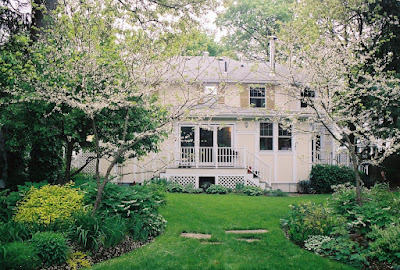What used to be a far-out, novel idea is now joining the mainstream: “Leave the leaves.” To support biodiversity and especially to provide protection for native insects, gardeners are changing our fall routine. For the past three years, I’ve been letting whole leaves lie on my garden beds.
 |
| Whole leaves work as mulch |
This change allows me to do a lot less work. I used to spend many hours in late October and early November raking leaves to a spot at the back of the house where I could plug in my leaf shredder. I’d feed as many leaves as possible into the machine--basically a string trimmer in a drum—to make shredded leaf mulch for my perennials.
 |
| Leaf shredder: effective but labor intensive |
Now I just gather leaves from the driveway, the sidewalk, and the roadway along our block, rake them onto a tarp, and drag the tarp into the backyard. There I dump the leaves on whatever bed seems to need a blanket of mulch.
The concept behind this time-saving approach is that lots of native insects overwinter in fallen leaves, whether as eggs, larvae, nymphs, or adult insects. When I chop up leaves in the shredder, I’m chopping up those insects, reducing next year’s population of native insects in my yard. That’s working against myself, because I need a balanced population of leaf eaters, pollinators, and beneficial insects—the predators that keep leaf eaters in check—to keep my garden ecosystem healthy.
 |
| I want to host beneficials like this lacewing |
While environmentalists and proponents of sustainable gardening advocate for leaving the leaves, I’m disappointed to notice that some of my favorite garden writers are pushing back. I’ve read warnings that a cold-season mat of whole leaves will damage turf grass. Yes, we all knew that! Another worry is that perennials won’t thrive under a blanket of leaves. The thought is that plants from Mediterranean climates may need breathing room and a drier environment.
All I can say is that these commentators must be gardening very differently than I do. Most of what used to be turf grass in our yard is now covered with wood chips that have no trouble accommodating a layer of fall leaves. And my perennials are ones that have proven tough enough to survive the conditions in the yard—sandy soil, rabbits, varying degrees of shade, humid summers with periods of drought and, increasingly, cold snaps in winter without snow cover for protection. If perennials needed pampering, they’ve long since died out in my garden.
 |
| Lavender toughs it out in the garden without special treatment |
Given my limited perennial-growing ambitions, I’ve had no trouble with leaving the leaves. Increasing numbers of birds visiting the yard suggest we’ve got more native insects than we used to.
In spring I do like to peel back the matted leaves from the newest perennial bed off the back deck. It’s quick work to dump them in the wheelbarrow and move them to the compost piles. If I’ve got some dry fall leaves in bags in the garage, I’ll shred them at that time to replace the mulch I’m taking away. Moderation in all things.
 |
| Dwarf crested iris, another survivor |












































